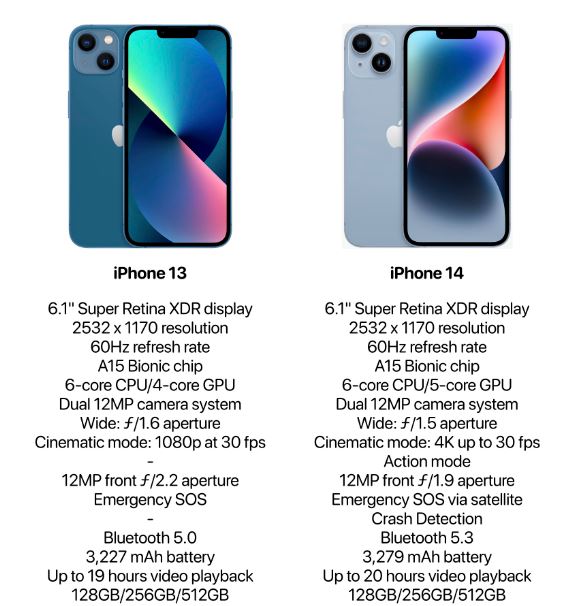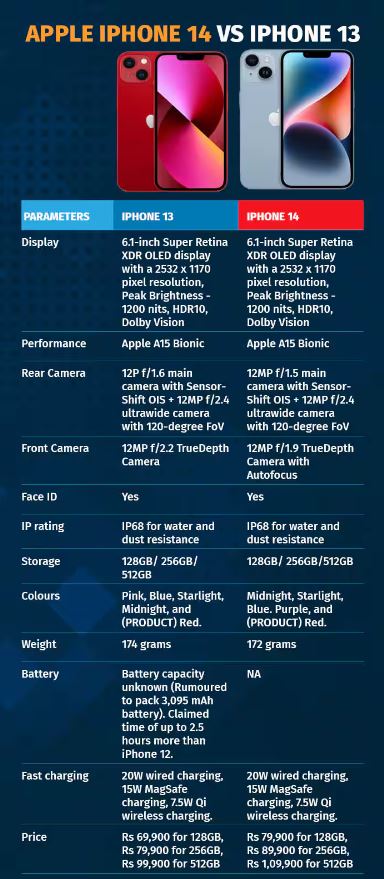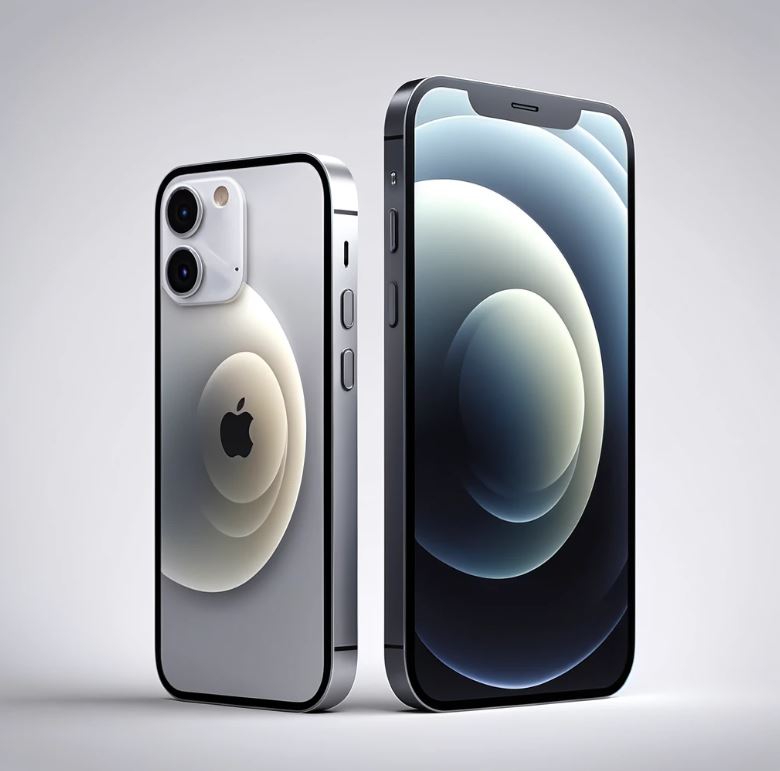What is the difference between iPhone 13 and iPhone 14? Apple continues to innovate with each new iPhone release, and the transition from the iPhone 13 to the iPhone 14 is no exception. Both models exemplify Apple’s dedication to pushing the boundaries of what a smartphone can achieve with cutting-edge technology, premium build quality, and highly optimized software. The most significant difference between the iPhone 13 and the iPhone 14 lies in the introduction of new safety features like Emergency SOS via satellite and enhancements in camera technology for better low-light performance.

What is the iPhone 13?
The iPhone 13 was introduced as a significant upgrade over its predecessor, focusing on enhanced battery life, improved processing power, and better photographic capabilities. It features a 6.1-inch Super Retina XDR display, delivering vibrant visuals and true-to-life colors. Powered by Apple’s A15 Bionic chip, the iPhone 13 offers a seamless and fluid user experience, capable of handling everything from everyday tasks to high-demand applications without a hitch.
The dual-camera system on the iPhone 13 was lauded for its ability to capture stunning photos under a variety of lighting conditions, supported by advanced computational photography features like Photographic Styles and Cinematic mode. Additionally, its durable design with Ceramic Shield and aerospace-grade aluminum ensures a robustness suited for everyday challenges.
- Display: 6.1-inch Super Retina XDR.
- Processor: A15 Bionic chip.
- Camera: Advanced dual-camera system.
- Durability: Ceramic Shield and aerospace-grade aluminum.
What is the iPhone 14?
Building on the strong foundation set by the iPhone 13, the iPhone 14 introduces several key enhancements that refine the user experience. It maintains the 6.1-inch display size but includes a new Photonic Engine for improved photo processing, significantly enhancing performance in low-light conditions. The A15 Bionic chip continues to power the device but now comes with an additional GPU core in some models, boosting graphics performance.
The iPhone 14 stands out with its new safety features, including Emergency SOS via satellite and crash detection, setting a new standard for smartphone safety. The camera upgrades and the introduction of Action mode for video add further value, making it a compelling upgrade for those interested in the latest technological advancements in mobile photography and safety.
- Display: Enhanced 6.1-inch Super Retina XDR with Photonic Engine.
- Safety Features: Emergency SOS via satellite and crash detection.
- Camera: Upgraded system with Action mode.
- Performance: Boosted by a new 5-core GPU in some models.
Examples of iPhone 13 Usage
The iPhone 13 is highly versatile, catering to a broad audience with its balance of performance and portability:
- Capturing high-quality photos with ease using its sophisticated camera system.
- Streaming video content in stunning detail on its Super Retina XDR display.
- Running demanding apps smoothly, thanks to the A15 Bionic chip.
- Withstanding daily wear and tear, reinforced by its durable design.

Examples of iPhone 14 Usage
The iPhone 14 expands its appeal with enhanced features that cater to both safety-conscious
users and multimedia enthusiasts:
- Utilizing the Photonic Engine for superior photography in low-light environments.
- Leveraging the new safety features like Emergency SOS via satellite during outdoor adventures or in remote areas.
- Recording smoother, more stable videos with Action mode, ideal for capturing dynamic scenes.
- Enjoying extended gaming sessions with improved graphics performance due to the added GPU core.
History of the iPhone 13
Introduced in 2021, the iPhone 13 series marked a significant step in Apple’s mobile technology journey. It built upon the redesigned elements introduced with the iPhone 12, focusing on enhanced user experiences and refining existing technologies:
- 2021 Launch: Continued the aesthetic and innovation trends set by the iPhone 12.
- Technological Enhancements: Included a more powerful A15 Bionic chip and improved battery life.
- Photography Upgrades: Introduced Photographic Styles and Cinematic mode.
- Public Reception: Received praise for its balanced improvements and reliable performance.
History of the iPhone 14
The iPhone 14, launched in 2022, continued to push the boundaries of what consumers expect from their mobile devices, particularly in terms of safety and camera capabilities:
- 2022 Launch: Emphasized incremental improvements with groundbreaking safety features.
- Safety Innovations: First iPhone to include Emergency SOS via satellite and crash detection.
- Camera Improvements: Enhanced with Photonic Engine for better low-light performance.
- Market Impact: Set new standards for mobile safety technologies.
Similarities Between iPhone 13 and iPhone 14
Despite the advancements, the iPhone 13 and iPhone 14 share several core features that underline Apple’s consistent approach to smartphone design and functionality. Both models boast a 6.1-inch Super Retina XDR display, ensuring vivid and crisp visuals for all types of content. They are powered by the same A15 Bionic chip, although the iPhone 14 has a version with an additional GPU core, and both support iOS’s latest updates, maintaining a seamless user interface across generations.
- Consistent Design Ethos: Both feature a sleek, durable build with aerospace-grade aluminum.
- Software Continuity: Run on the same iOS platform with regular updates.
- Photographic Capabilities: Equipped with advanced dual-camera systems.
- 5G Connectivity: Ensure fast internet speeds for efficient browsing and downloading.
Differences Between iPhone 13 and iPhone 14
The distinctions between the iPhone 13 and iPhone 14, while subtle, are significant for certain users. The iPhone 14’s enhanced camera system with the Photonic Engine offers a substantial improvement in low-light photography, making it a better choice for photography enthusiasts. Additionally, the introduction of safety features like Emergency SOS via satellite provides added security for users who often find themselves in remote locations or require reliable safety tools on their device.
- Camera Technology: iPhone 14 offers superior low-light performance.
- Safety Features: iPhone 14 includes innovative safety technologies not found in the iPhone 13.
- Graphics Performance: Enhanced in the iPhone 14 with an additional GPU core.
- Innovative Video Capabilities: iPhone 14’s Action mode for capturing high-quality video under motion.
Summary – iPhone 13 vs iPhone 14
The iPhone 13 and iPhone 14 represent evolutionary steps in Apple’s smartphone lineup, with each model catering to the needs of a diverse user base. While the iPhone 13 provides a solid, reliable experience with robust performance and excellent photography capabilities, the iPhone 14 enhances these features with superior low-light camera performance, groundbreaking safety features, and slightly better graphics handling. For users deciding between the two, the choice comes down to prioritizing the latest camera and safety enhancements over the already impressive capabilities of the iPhone 13.
Facts about iPhone 13
- Display: 6.1-inch Super Retina XDR display.
- Processor: A15 Bionic chip, providing robust performance for all types of applications.
- Camera: Dual-camera system with 12 MP ultra-wide and wide cameras.
- Battery Life: Up to 19 hours of video playback.
- Design: Aerospace-grade aluminum and ceramic shield front cover.
Facts about iPhone 14
- Display: 6.1-inch Super Retina XDR display, same as the iPhone 13 but with brighter output.
- Processor: A15 Bionic chip, same as iPhone 13 but with a new 5-core GPU for better graphics performance.
- Camera: Advanced dual-camera system with Photonic Engine for better low-light performance.
- Battery Life: Improved battery management for slightly longer life than iPhone 13.
- Safety Features: Introduction of Emergency SOS via satellite.
FAQ – Difference Between iPhone 13 and iPhone 14
1. What are the main camera differences between the iPhone 13 and iPhone 14?
- The iPhone 14 features a Photonic Engine that significantly improves low-light performance over the iPhone 13.
2. Are the iPhone 13 and iPhone 14 the same size?
- Yes, both have a 6.1-inch display and nearly identical dimensions.
3. Can both models use 5G?
- Yes, both the iPhone 13 and iPhone 14 support 5G connectivity.
4. What new safety features does the iPhone 14 have?
- The iPhone 14 introduces Emergency SOS via satellite and crash detection.
5. How does battery life compare between the two models?
- The iPhone 14 offers slightly improved battery life due to more efficient power management.
6. Are there any performance differences?
- While both use the A15 Bionic chip, the iPhone 14 includes a new 5-core GPU for enhanced graphics performance.
7. What are the color options for both models?
- Both models come in various colors, though the iPhone 14 introduces new hues.
8. Do both models support iOS updates equally?
- Yes, both are capable of running the latest iOS version, ensuring up-to-date features and security.
9. Is there a difference in the build materials?
- Both are built with aerospace-grade aluminum and a ceramic shield front cover.
10. What is the price difference between the iPhone 13 and iPhone 14? – The iPhone 14 is generally priced slightly higher, reflecting its new features and enhancements.
5 Detailed Questions
- How does the introduction of the Photonic Engine in the iPhone 14 enhance photo quality compared to the iPhone 13?
The Photonic Engine in the iPhone 14 represents a significant advancement in photography, especially in low-light environments. This new technology allows for more light capture and better detail preservation, resulting in clearer and more vibrant images. The Photonic Engine processes images in a way that maximizes the detail and color accuracy of the photos taken, especially under challenging light conditions. By combining this with the computational photography capabilities of the A15 Bionic chip, the iPhone 14 provides a substantial improvement in photo quality over the iPhone 13. Users can expect enhancements in texture, color, and reduced noise in photos, making the iPhone 14 an ideal choice for photography enthusiasts who demand high-quality imagery.- Enhanced low-light performance: Significantly better detail and color accuracy.
- Improved image processing: Optimizes textures and reduces noise.
- Ideal for photography enthusiasts: Offers high-quality photos under various lighting conditions.
- What impact does the new 5-core GPU in the iPhone 14 have on gaming and multimedia applications compared to the iPhone 13?
The introduction of the 5-core GPU in the iPhone 14 enhances its performance significantly in gaming and multimedia applications. This upgrade allows for richer graphics and smoother gameplay, particularly in resource-intensive games and apps that require high graphic fidelity. Users will notice improved frame rates and enhanced visual effects, providing a more immersive gaming experience. Additionally, the 5-core GPU supports advanced video processing capabilities, making the iPhone 14 better suited for editing high-resolution videos directly on the phone. This makes it an attractive option for content creators who need powerful performance for media creation on the go. The increased GPU cores also mean better efficiency in handling multiple tasks simultaneously, reducing lag and improving the overall responsiveness of the device.- Enhanced gaming experience: Higher frame rates and better graphics.
- Improved video editing capabilities: Supports high-resolution video processing.
- Efficiency in multitasking: Reduces lag and enhances responsiveness.
- How does the battery life of the iPhone 14 compare to the iPhone 13 when used extensively for video streaming?
With improvements in battery management technology, the iPhone 14 offers slightly better battery performance compared to the iPhone 13, particularly noticeable during extended video streaming sessions. The iPhone 14’s battery is optimized to handle higher power demands more efficiently, which is essential when streaming high-definition content. Users can expect the iPhone 14 to last longer on a single charge under similar usage conditions, providing an advantage for those who frequently watch videos or stream content. This is further supported by the device’s ability to manage background activities more effectively, ensuring that power is prioritized for video playback. The slight increase in battery capacity and the optimization of the iOS platform contribute to this improved endurance, making the iPhone 14 a reliable companion for media consumption.- Longer streaming duration: Enhanced battery management for extended video play.
- Optimized power usage: Better background activity management.
- Reliable media consumption: Ideal for heavy video users.
- What are the advantages of the iPhone 14’s Emergency SOS via satellite over the traditional emergency services available on the iPhone 13?
The Emergency SOS via satellite feature introduced in the iPhone 14 provides critical communication capabilities in situations where traditional cell services are unavailable. This feature is particularly beneficial for users in remote or underserved areas where cellular connectivity is limited or non-existent. It allows users to send messages to emergency services and contacts via satellite, ensuring that help can be reached even from the most isolated locations. This technology not only enhances safety but also provides peace of mind for adventurers, travelers, and people living in areas prone to natural disasters. The iPhone 14’s ability to connect to satellites can be a lifesaver, literally, by providing a reliable line of communication when it is most needed. Furthermore, this feature includes precise location sharing with emergency services, facilitating faster and more accurate response times, which can be crucial in emergency situations.- Connectivity in remote areas: Ensures communication where cell service is absent.
- Enhanced safety and peace of mind: Ideal for travelers and those in isolated regions.
- Accurate emergency response: Shares precise location with responders.
- How do the material and build quality enhancements in the iPhone 14 contribute to its durability compared to the iPhone 13?
The iPhone 14 continues to use the aerospace-grade aluminum frame and Ceramic Shield front cover, both of which were present in the iPhone 13, but with further enhancements to their formulation. These material improvements contribute to a higher resistance to scratches and drops, making the iPhone 14 even more durable than its predecessor. The improved build quality ensures that the device can withstand the rigors of daily use more effectively, reducing the likelihood of damage from accidental mishaps.
Additionally, the iPhone 14’s structure is reinforced to provide better water and dust resistance, ensuring it maintains functionality in a variety of environmental conditions. This is crucial for users who frequently use their device outdoors or in potentially hazardous situations. The design refinements also extend to better thermal management, which preserves the internal components, prolonging the device’s lifespan even under intense use such as gaming or high-performance tasks. This comprehensive approach to durability makes the iPhone 14 a robust choice for anyone looking for a reliable and resilient smartphone.
- Enhanced scratch and drop resistance: Improved materials for greater durability.
- Better environmental resistance: Optimized for water and dust protection.
- Superior thermal management: Maintains performance and prolongs lifespan.
These detailed questions and answers provide a comprehensive view of how the iPhone 14 builds upon the solid foundation laid by the iPhone 13, introducing enhancements that cater to both everyday users and those with specific needs such as enhanced safety, better performance in multimedia applications, and improved durability for long-term use.
